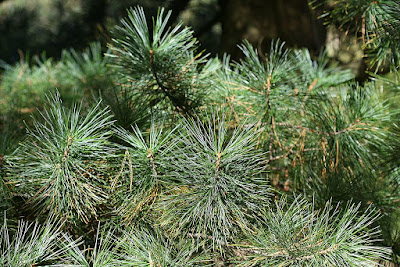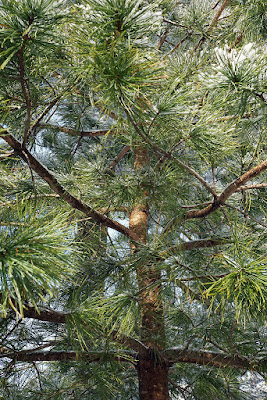Pinus koraiensis is native to China (Heilongjiang, Jilin); Japan (Honshu); Korea, Democratic People's Republic of; Korea, Republic of; Russian Federation (Amur, Primoryi, Khabarovsk). It grows in dry places on podzols among deciduous broad-leaved trees like oaks, poplars and birches at elevations of 200 to 2500 meters above sea level.
Pinus koraiensis also called as Korean pine, Chinese pinenut, is a species of the genus Pinus. This species was described by Philipp Franz von Siebold & Joseph Gerhard Zuccarini in 1842.
IDENTIFY PINUS KORAIENSIS - KOREAN PINE PLANTS
Pinus koraiensis is native to China (Heilongjiang, Jilin); Japan (Honshu); Korea, Democratic People's Republic of; Korea, Republic of; Russian Federation (Amur, Primoryi, Khabarovsk). It grows in dry places on podzols among deciduous broad-leaved trees like oaks, poplars and birches at elevations of 200 to 2500 meters above sea level.
Chinese pinenut is a trees which reaching up to 50 m tall with gray-brown or gray bark, fissured longitudinally into irregularly oblong plates, inner bark red-brown. The branchlets densely red-brown, occasionally yellow pubescent. Winter buds reddish brown, oblong-ovoid, slightly resinous. Needles 5 per bundle, dark green, straight, almost triangular in cross section, 6-12 cm, stomatal lines 6-8 along each abaxial surface, blue-gray, vascular bundle 1, resin canals 3, median, base with sheath shed, margin serrulate. Seed cones solitary or several clustered near apex of 1st-year branchlets, erect, pedunculate (peduncle 1-1.5 cm), conical-ovoid or ovoid-oblong, 9-14 x 6-8 cm, indehiscent or slightly dehiscent at maturity, with seeds exposed but not shed. Seed scales reflexed at apex. Seeds triangular-obovoid, 1.2-1.6 cm, wingless.
Korean pine is a popular ornamental plant in large parks and gardens in cold climates, such as eastern Canada and the northeastern United States, with rapid but steady development. in many places. It is resistant to cold winters with temperatures down to around -50 ° C.
The timber is used for construction, bridge building, vehicles, furniture, and wood pulp. The seeds are edible, medicinal, and used as a source of soap and lubricating oil. Turpentine is obtained from the timber and roots, and the bark yields tannin.
PINUS KORAIENSIS - KOREAN PINE PLANTS CARE AND CULTIVATION
The cultivation of these plants presents no special difficulties, if proper soil and exposure are available. The question of hardiness is, of course, all-important. It is not only the problem of temperature the given tree will stand, but also the exposure to winds, and, to a considerable extent, the source from which the tree is derived. If the plants are raised from seeds matured in similar or even more rigorous climates, they are usually more hardy.
Soils:
Pinus koraiensis prefer a well-drained porous gravelly subsoil, overlaid with a light sandy loam. They seem to be particularly happy in a soil underlaid with a porous glacial drift. In cultivation, however, they succeed very well in ordinary well-drained soil. When the plants are set in clay soil, which is often done, the soil should be thoroughly loosened by trenching or subsoil plowing, and well under drained. Any available humus, wood ashes, and well-rotted manure incorporated in the soil greatly aid in rendering it friable and porous for the roots.
Manures and mulches:
Mulching with ordinary well-rotted barnyard manure in late autumn affords much stimulus to growth. By the following spring the manure will be in a desiccated condition and can be incorporated with the soil. A heavy mulch of old straw, rotten hay, or any similar material over the roots, and this was maintained throughout the entire growing season is benefit to the plants in a more or less juvenile condition.
In many cases manure is not obtainable. In such event, newly moved plants should be heavily mulched with rotten straw, rotten hay, or any similar rubbish for a few years until they become established. The frequent stirring of the ground over the roots subsequently will conserve sufficient moisture.
An area extending from the stem to one to two feet beyond the branches, stirred up with hoe and rake perhaps five or six times throughout the growing season, is very beneficial in conserving the moisture around the roots.
Pruning:
Removal of the lower branches of Korean pine is a serious mistake, and, if healthy, they should be retained to the base. Occasional removal of the central buds in spring to produce a dense lateral growth is beneficial. Pruning or disbudding can be intelligently performed to add much to the natural symmetry. The extraction or removal, early in spring, of the central or terminal bud, will tend to compel the branches which start from the side buds to spread apart and form a much denser growth. Cutting back the previous year's terminal growth to a strong bud or branchlet on the main limbs over the tree, if the plant is inclined to be thin in its branching, always produces a much denser lateral growth.
Transplanting:
Transplanting can be done at all times of the year, excepting midsummer when they are in full growth. The best success is secured in spring when the buds begin to swell. From the end of August to the middle of September, if there have been abundant rains and the ground has been well soaked, is a very good time to move the plants. They may be planted late in autumn when circumstances compel it, but there is likely to be a considerable percentage of loss. Their roots are very susceptible to injury from exposure to the air, and the utmost vigilance should be exercised to keep them covered and moist.















COMMENTS